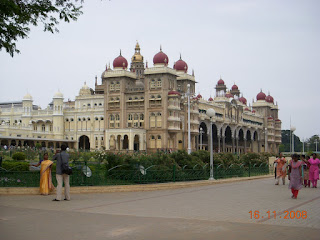

We took the scenic route to KRS through Pandavpura, which basically meant that we stopped for directions every couple kilometres. Scenic it definitely was: paddy and sugarcane fields as far as the eye could see, with low blooms of cabbage and greens, long rows of gauzy greenhouses busy with young growth. We came to the turn-off for KRS at a bridge over a hurried and rather musty smelling canal. The KRS dam loomed ahead a long, long wall ahead, cocooning the Brindavan garden.
The Royal Orchid hotel sits a square colonial bungalow on a bluff overlooking the garden, and was built by Kishnarajendra Wodeyar as a guest house. The colonial splendour remains untouched with the original wood panelling, teak staircases and the antique floor tiles evoking memories of a bygone, more elegant era. As I walked the hallway, I was struck with the inexplicable urge to whisper, as if not to disturb residing royalty. It was all very swish and sophisticated, what with all the Belgian glass and the martyred animals on the wall. The lobby was a large airy space with cane couches and an ornate silver jhula that we had to plonk into the minute we set eyes on it! We were led to our room on foot up two flights of stairs, no bland impersonal elevators to mar the ambience. Our room, a Queen suite, was lush with gold and jewel tones all around. But the pièce de résistance we discovered after the bellhop with a subtle dramatic flair, threw open the balcony doors. There lay before us the
Early evening was spent lounging around the pool and terraces of the hotel, and as the sun crossed over from scalding to merely hot, we climbed down a small fleet of stairs and stepped right into Brindavan. We took a walk along the little paths and trails between the lawns and fountains, while the variety of plants and shrubs stretched the limits of my botanical knowledge. As twilight approached, we crossed a bridge over an unfortunately cluttered canal to enter the musical fountain arena. As the show started, I felt with a sinking traitorous heart that the musical fountain that awed and thrilled us as kids now merely seemed jaded and sadly outdated. A jarringly loud Usha Uthup fought with our barely restrained sniggers, and we gave up after the omnipresent Saare Jahan Se Acchha. Brindavan is extremely photogenic at night. The hotel had conveniently placed benches on a walkway overlooking the garden, and we spend a serene but mosquito-ridden hour admiring the view below and constellations overhead. Returning to our room, we encountered the shyly chatty receptionist who regaled us with Sir MV anecdotes (Sir MV being the one who designed and build the KRS Dam). Apparently, Sir MV had the curious habit of including in his constructions one particular stone upon which the whole structural integrity rested. He was commissioned to design and build a bridge in
Breakfast was served on the enclosed terrace overlooking the dam gates and pool, and a lovely mellow light permeated through the antique glass windows. Though we still had a couple of hours till we checked out, they were heavy with the knowledge that our lovely two day break was almost done! To my delight, the hotel offered bicycles to any guest wanting to take a turn around the garden. And so it came that after a gap of 16 years, I perched precariously on one and started off, rather shakily. But you know what they say about learning to ride, and half the ride was a breeze. The other half we burned our breakfast calories pushing the bicycles back up the hill.
And so our little break came to pass, and we find ourselves back in dusty








